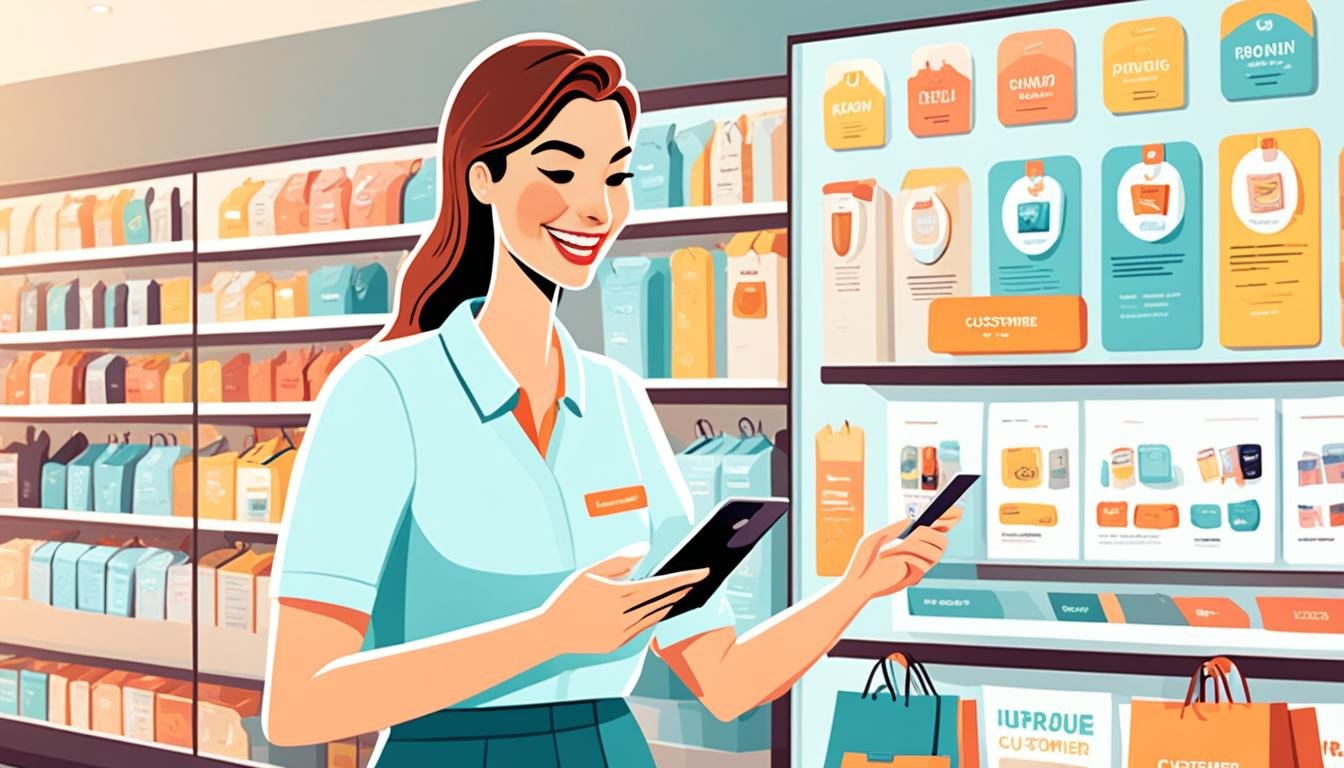Personalized Customer Journeys: Creating tailored experiences.
Did you know that 82% of consumers look for personalized experiences when shopping? This shows how crucial Personalized Customer Journeys are. By making interactions unique, businesses can boost customer loyalty. This leads to more repeat buys and word-of-mouth.
In today’s market, we need smarter ways to improve customer experience. Old methods are hard to use because they mix complex data from different places. This often means missing chances to really make customer engagement tactics personal and give bespoke consumer interactions.
For companies, success comes from really knowing what customers want. It’s about making their journey smooth from start to finish. When done right, these personalized experiences go beyond what customers expect. This builds strong loyalty and helps the business do better overall.
Key Takeaways
- 82% of consumers are influenced by personalized experiences during their purchase decisions.
- Integrated data across touchpoints is crucial for effective personalization.
- Personalization increases the likelihood of repeat purchases and customer loyalty.
- Experience orchestration automates the coordination of people, systems, and data to enhance customer experiences.
- AI and machine learning play significant roles in predicting customer behavior and tailoring experiences.
Introduction to Personalized Customer Journeys
In today’s market, knowing what each customer wants is key. Brands use personal data to make unique interactions that make shopping better. This way, every customer feels special, leading to more loyalty.
What Are Personalized Customer Journeys?
Personalized customer journeys map out the customer’s feelings and needs at every step, from finding out about a product to after buying it. Brands use customer data to tailor their approach to each person’s likes and history. By looking at feedback and website stats, brands can spot areas to improve, making shopping smoother for everyone.
Importance of Personalization in Modern Business
Personalization is vital in today’s business world. Studies show 78 percent of customers want more personalized experiences. Personalized efforts can bring in up to 40 percent more revenue than generic ones.
Creating custom messages at each stage of the journey makes shopping better and keeps customers coming back. Mapping out the customer journey and segmenting them helps in making these personalized plans. Salesforce found that 67 percent of marketing leaders see a connected customer journey as key to their strategy.
The Role of Data in Creating Personalized Experiences
Data is key to making personalized customer journeys. It helps businesses create unique experiences for each customer. By using customer data analytics, companies learn what their customers like and need.
First, businesses gather data from many places like purchase history and online actions. This info helps make detailed customer profiles. With behavior tracking, companies can send out personalized content and offers.
Also, data helps with real-time personalization. This means companies can change their approach as they go along. Since 71% of people want personalized experiences, it’s key to get it right. McKinsey says personalization can make marketing 10 to 20 percent more efficient, which could mean more sales.
Making detailed customer profiles means looking at many things like demographics and what they like to buy. Using both first-party and third-party data makes personalization better. First-party data, from customers directly, gives deep insights into what they do.
Also, checking how customers feel through surveys helps make things better. Data shows that using insights to improve interactions can boost engagement and satisfaction. For example, personalized messages can lead to more sales than general ones.
It’s important to keep checking and improving these personalized plans. Look at things like email clicks and how many customers stay with you. Netflix’s personalized recommendations show how well this works. Spotify’s Wrapped campaign got 3 billion streams in 2019, proving data-driven personalization can be a hit.
In short, data is vital for making experiences feel personal. By using customer data analytics, behavior tracking, and real-time personalization, companies can keep customers coming back.
Understanding Customer Experience Orchestration
Customer Experience Orchestration makes sure customers get a smooth, personalized experience by linking different systems and channels. It makes sure data and actions work together. This way, customers get a consistent message at every touchpoint.
It relies on key things like capturing feedback from all channels, having one view of customer data, analyzing things in context, and making decisions quickly.
How Experience Orchestration Enhances Personalization
With experience orchestration, companies can overcome departmental barriers and focus on making the whole experience better. This leads to better customer engagement by sending personalized messages on different channels. It also helps in finding chances to sell more things, making customers more engaged.
Examples of Experience Orchestration in Action
Experience orchestration is great at making customer journeys smooth. For example, airlines can give personalized help by combining data from past visits, loyalty status, and flight info. This makes support more tailored and helps keep customers coming back.
Also, it uses feedback from all channels to send messages that really speak to each customer. This boosts lead generation and sales. Tools like Bloomreach Engagement are key in managing and improving these customer journeys.
Segmentation: The Foundation of Personalization Strategies
In the world of digital marketing, segmentation is key to making personalization work. It involves creating customer profiles, segmenting the market, and targeting behaviors. This way, marketing can really speak to each customer group’s unique tastes.
Importance of Customer Segmentation
Segmenting customers is vital for making marketing personal. By sorting customers by who they are, what they buy, and their value, companies can send messages that hit the mark. For example, email segmentation boosts engagement, with better open and click rates. This leads to happier customers and more loyalty.
Effective Segmentation Techniques
Businesses can use frameworks like PIE (Potential, Importance, Ease) and data analytics for better segmentation. These tools help focus on the most valuable customers and tailor strategies for them. Adding machine learning and predictive analytics sharpens these efforts. Using detailed customer data is key to successful segmentation.
Aligning Segmentation with Personalization Efforts
Linking segmentation with personalization makes marketing more powerful. This combo leads to more engaging and positive experiences, which builds loyalty. Targeted marketing campaigns can increase revenue by up to 760%. By meeting the specific needs of different groups, brands boost loyalty, ROI, and conversion rates.
Data-Driven Marketing and Its Impact on Customer Journeys
Data-Driven Marketing is changing how businesses connect with customers. It uses predictive analytics for better, more personal experiences. By combining lots of customer data, companies can send messages and offers that really speak to each person. This makes customers happier, more loyal, and helps businesses grow.
Harnessing Customer Data for Personalization
Using customer data well is key to making marketing personal. It means looking at what customers have done before to guess what they might do next. This helps brands offer services that fit what each customer wants. Studies show that 66% of customers want companies to know their needs, making data-driven strategies very important.
Leveraging Analytics for Better Insights
Predictive analytics and other advanced tools help make sense of customer data. These tools give businesses tips to quickly change with customer trends. For example, AI and machine learning can make customer profiles and insights even more accurate. This means knowing which marketing campaigns work best with certain customers, helping to improve engagement and sales.
- US companies are estimated to lose between $75 billion to $1.6 trillion annually due to poor customer service experiences.
- Proactive use of data-driven marketing results in better performance, leading to a competitive advantage.
- Successful businesses often structure their teams with roles like a chief experience officer to ensure seamless customer journey management.
Personalized service based on strong customer insights and predictive analytics leads to better marketing outcomes. Companies that invest in big data and analytics can better understand customer behavior. This helps them plan better and offer amazing personalized experiences. By using these tools, businesses can keep customers coming back and make them happier, leading to long-term success.
Implementing Personalized Recommendations
Personalized recommendations are key to a great customer experience today. By using advanced AI, businesses can offer suggestions just for you. This makes shopping more fun and helps keep customers coming back.
Benefits of Tailored Product Suggestions
Customized product suggestions make customers happier and more loyal. Studies show 73% of shoppers want companies to know what they like. With recommendation engines, businesses can show products that match what customers want, leading to more sales and better relationships.
Also, 56% of shoppers expect personalized offers all the time. This shows how important it is to have a smart system for making recommendations.
Technological Tools to Enhance Recommendations
Using the right tech is key for great personalized shopping. AI and machine learning look at lots of data to make smart suggestions. These tools make giving personalized products easier and make shopping better, helping keep customers around.
For online stores, personalization is a must to stay ahead. With 52% of marketers wanting to get better at managing data, using the right tech is crucial. This way, businesses can use customer data well, making their personalized offers even better.
Targeted Content Strategies for Improved Engagement
In today’s market, getting the right message to the right people is key. Companies are now focusing on making content that fits what their customers want and need.
Creating Relevant Content for Different Segments
To make sure content hits the mark, it’s important to know what different customers like. By using targeted messages and segmenting customers, companies can make experiences that really connect with people.
- Starbucks boosts loyalty with its “Birthday Treat” program.
- Wealthsimple and Toronto-Dominion Bank use targeted sales to strengthen customer ties.
- Amazon shows that tailored product suggestions can lift sales and customer value.
A big 76% of North American shoppers say getting personalized messages matters to them. Epsilon’s findings back this up, showing that personalized emails bring in six times more sales than general ones.
Omnichannel Personalization: Connecting Every Touchpoint
Omnichannel marketing makes sure customers get a consistent experience across all touchpoints. This is key for making content that feels right for each customer, no matter where they are in their journey.
Big names like DoorDash and Uber Eats use location and timing to make offers that hit the spot. Evergage’s data shows 88% of marketers see real gains from website personalization.
Omnichannel personalization builds a strong brand experience that boosts customer engagement and results. By using data and focused messages, companies can forge stronger bonds with customers. This leads to more loyalty and sales.
Enhancing Customer Support through Personalization
Personalizing customer support means using new tech and strategies to give each customer a unique experience. With more people using digital ways to talk, they want quick and relevant help. A 2019 survey showed retailers plan to spend 30% more on making things personal, showing how big an impact it can have.
In 2019, Forbes Insight found 41% of marketers see personalization as key to a great customer experience. By making support personal, companies can change how they help customers, making them happier and more satisfied.
Contextual Support Across Channels
Having support teams quickly get to know customers through emails, texts, and social media is key. Automation rules can deflect up to one-third of easy and not-so-important customer service questions, letting agents deal with harder issues. This means support can be more focused and helpful, based on what customers have done before and what they like.
Also, 42% of people like talking to customer service on messaging apps more than other ways. These apps let customers get help fast, showing how important quick and relevant support is. People check their phones about 96 times a day, making texting a good way to talk to support quickly and easily, which makes customers happier.
Real-World Examples of Personalized Customer Support
Many companies, like Amazon and Netflix, use customer info to give them personalized help and suggestions. They use data to make sure support agents know everything about customers, helping them solve problems faster and build a positive image.
Starting chats with an autoresponder gives customers a quick hello, making things smoother for support teams. By sorting tickets by how urgent they are, how loyal the customer is, and what kind of issue it is, companies can make support better. Using pictures in messages also makes talking to customers more engaging and relevant.
Using both tech and human insights, like eye-tracking, helps companies see how personal touches affect customers. These advanced methods make support better and build stronger bonds with customers.
Overcoming Challenges in Delivering Personalized Customer Journeys
Many companies struggle with personalizing customer experiences. A big issue is the siloed data problem, with 64% of leaders saying it hinders their efforts. Without integrated systems, it’s hard to personalize interactions, leading to inconsistent experiences for 43% of people.
To overcome these hurdles, a structured approach is key. It starts with having easy access to all customer data. Using technology is also vital. Companies need tools that collect and analyze data in real-time.
For example, platforms that track customer behavior across all channels are crucial. Over 75% of respondents struggle to measure their CX efforts’ success. This shows the need for strong tech solutions. These tools help personalize on a large scale and keep experiences consistent across all touchpoints.
Managing and securing customer data is another challenge. It’s important to protect privacy while still getting valuable insights. Poor communication between departments affects 72% of businesses, making personalization less effective. To fix this, companies should improve communication and use integrated systems.
A travel company that used a Real-Time CX Platform saw a 19% increase in conversions and a 15% boost in satisfaction. This shows how overcoming these challenges can lead to better results.
It’s crucial to align personalization with company goals and keep refining strategies based on customer feedback. By understanding and acting on customer data, companies can better overcome personalization challenges. This leads to better and more consistent customer experiences.
Source Links
- Unlocking the secrets of personalized customer journeys
- How Personalized Customer Experiences Drive Business Growth
- How to personalize complex journeys for an exceptional customer experience
- How to create personalized customer journey maps
- Customer Journeys: How to Keep Customers Connected and Coming Back
- How to create a personalized customer experience using data
- How to use data to deliver a personalized customer experience
- Why You Need Experience Orchestration
- The Ultimate Guide to Journey Orchestration
- Connecting With Customers: Segmentation vs Personalization
- Personalize Customer Experiences with Powerful Segmentation
- The Power of Personalization: Revolutionizing Marketing Strategies
- How Brands Can Make the Customer Journey More Data Driven for CX
- Competing on Customer Journeys
- Unlock the Power of a Personalized Customer Journey | Monetate
- Five-Step Guide to Creating a Personalized Customer Experience | Pantheon.io
- Mastering Personalized Customer Experiences for Greater Engagement
- Personalization in Digital Marketing – What Your Customers Want?
- Mastering Customer Journeys: The Ultimate Guide For 2024
- Enhancing playful customer experience with personalization
- Personalized Customer Service: 9 Steps to Achieving It
- Personalizing the customer journey: a case study
- Unlocking Success: Overcoming Customer Journey Challenges with Proven Solutions





